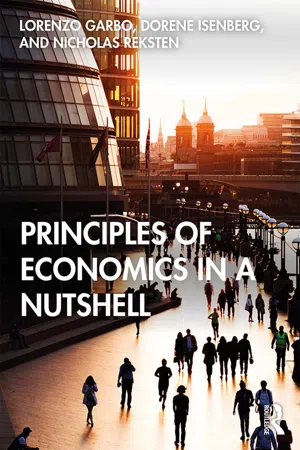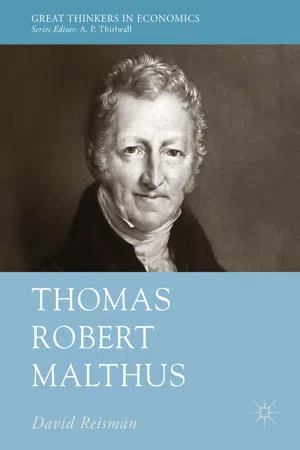Circular Flow of Income
The circular flow of income is a model that shows the flow of goods, services, and money in an economy. It demonstrates how households and firms interact through product and factor markets. In this model, households provide factors of production, such as labor and capital, to firms in exchange for income, which is then used to purchase goods and services.
5 Key excerpts on "Circular Flow of Income"
- eBook - ePub
- A J Brown(Author)
- 2013(Publication Date)
- Routledge(Publisher)
...CHAPTER 3 The Flows of Money MOST economies, as we have seen, are market economies in which individual families or productive enterprises do not produce most of what they themselves consume or store up, and do not themselves consume or store up most of what they produce—they sell most of their products for money and buy with money most of what they consume, or of what they add to their stocks of goods and equipment. In such an economy, therefore, most production is not simply an immediate attempt to meet the producers’ wants, and, except where production is centrally planned, the aggregate investment which comes about is not the result merely of decisions that so much ought to be accumulated. Between production on the one hand and consumption or accumulation on the other there intervene one or more exchanges of goods or services against money. The Circular Flow In order to form a clear picture of the monetary machinery by which a market economy works, let us start with the simplest kind of situation, in which all output is produced by enterprises (not necessarily private) for sale, and in which there is no saving, no foreign trade, and no taxation. In such a community, a sum of money equal to the full value of output is paid out in each period by enterprises to the people who provide them with labour, capital, or materials, or who draw profits from them—that is to say, this sum is paid out to households. The whole of this money is then paid back by households to enterprises in exchange for the goods which they want to consume. Now, it can be seen that, if the volume of production does not change, a simple system of this kind can go on working indefinitely, with a constant amount of money. Ignore profits for a moment and suppose that all the payments connected with production consist of wages, salaries, and similar items which are paid out at the end of each week...
- eBook - ePub
- Lorenzo Garbo, Dorene Isenberg, Nicholas Reksten(Authors)
- 2020(Publication Date)
- Routledge(Publisher)
...5 Understanding the wealth of nations National income accounting 5.1 Circular flows and fundamental macroeconomic identities We now need to shift our focus from a micro to a macro level. In the microeconomics section of the book we paid attention to the behavior of single agents of the economy, specifically the consumer and the producer (the firm). The variables we used were pertinent to these agents: fundamentally the relationships between price and quantity of goods and services, studied from the point of view of consumers and suppliers, respectively. A macroeconomic story, and some macroeconomic vocabulary When we approach the macroeconomy, the aggregate economy of a country, a region, and so on, the functions of the various economic agents change, as agents are not seen only as relating to a specific market but become the integrated engines of the economy taken as a whole. Thus, households not only demand goods and services, but also supply labor and capital to the production processes of the country. In exchange, they receive income that can be used to purchase consumption goods and services, pay taxes, and add to the households’ savings. Households’ savings are placed in the financial sector : banks receive savings and turn them around in the form of lending to firms for their investments, i.e., to purchase capital goods that will further their production processes in the future...
- eBook - ePub
- Joseph A Schumpeter(Author)
- 2017(Publication Date)
- Routledge(Publisher)
...Stocks in this sense are comparable to a river-bed rather than to the water which flows through it. The stream is fed from the continually flowing springs of labor-power and land, and flows in every economic period into the reservoirs which we call income, in order there to be transformed into the satisfaction of wants. We shall not enlarge upon this, but only observe shortly that it involves accepting a definite concept of income, namely Fetter’s, and excluding from its scope all those goods which are not regularly consumed. In one sense the circular flow ends at this place. In another sense, however, it does not, for consumption begets the desire to repeat it and this desire again begets economic activity. We shall be pardoned if we have not in this connection spoken of quasi-rent as we ought to have done. More serious at first sight appears to be the absence of any mention of saving. Yet this point will also be explained. In any case, saving would not play a great part in economic systems displaying no change. The exchange value of every quantity of a commodity for every individual depends upon the value of the goods which he can procure and actually intends to procure with it. As long as the latter is undecided, this exchange value will undoubtedly fluctuate according to the possibilities conceived at the time, and likewise it will alter if the individual alters the direction of his demand. Yet, when the best employment in exchange is found for any good, the exchange value remains at one and only one definite height, given constancy in the conditions...
- eBook - ePub
- David Reisman(Author)
- 2018(Publication Date)
- Palgrave Macmillan(Publisher)
...© The Author(s) 2018 David Reisman Thomas Robert Malthus Great Thinkers in Economics https://doi.org/10.1007/978-3-030-01956-3_8 Begin Abstract 8. The Circular Flow David Reisman 1 (1) Nanyang Technological University, Singapore, Singapore 8.1 Wealth 8.2 Value 8.3 Say’s Law 8.4 Oscillation and Trend 8.5 The Golden Mean 8.6 Restoring the Balance References Keywords Circular flow Aggregate over-supply Involuntary unemployment Wealth Value End Abstract There is production: land, labour and capital are combined in such a way as to generate final output where previously there had been only promise and potential. There is realisation: consumption, investment, government expenditure and net exports are national expenditure that finds the national product a home. A nation wants sustainable growth in its productive capacity without wasteful over-heating, underperformance or stagnation. A nation does not always get what it wants. Malthus was the spiritual heir to Adam Smith on self-sustaining growth. Yet he was also the witness to wars, disruptions, downturns and unemployment. If the population mechanism did not condemn honest men and women to vice and misery, then the circular flow might itself leave them hungry and poor. 8.1 Wealth Today, the definition is different. In the shadow of great economic statisticians like James Meade, Richard Stone and Simon Kuznets (Reisman 2017 : 20–24), the national product is defined to be the sum of new value added in a nation in a reporting year. Wherever possible it is measured through revealed preferences and subjective satisfactions rather than through the accountant’s paid-out costs or physical quantities. No distinction is made between goods and services. Primary, secondary or tertiary, if it crosses the frontier from firms to households it is a part of the national income. Today, every student has been schooled in the standard catechism. Things were different in the crucible years...
- eBook - ePub
- Joseph A. Schumpeter(Author)
- 2021(Publication Date)
- Routledge(Publisher)
...And since all know from experience how much they must contribute in order to get what they want, having regard to the condition that each share involves a certain contribution, the circular flow of the system is closed, and all contributions and shares must cancel out, whatever the principle according to which the distribution is made. The assumption is so far made that all the quantities concerned are empirically given. This picture may be refined, and made to yield more insight into the functioning of the economic system, by means of a well known device. We assume all this experience to be nonexistent, and reconstruct it ab ovo, 8 as if the same people, still having the same culture, tastes, technical knowledge, and the same initial stocks of consumers’ and producers’ goods, 9 but unaided by experience, had to find their way towards the goal of the greatest possible economic welfare by conscious and rational effort. We do not thereby imply that people would in practical life be capable of such an effort. 10 We merely want to bring out the rationale of economic behavior irrespective of the actual psychology of the households and firms under observation. 11 Neither do we aim at giving a sketch of economic history. Not how the economic process developed historically to the state in which we actually find it, but the working of its mechanism or organism at any given stage of development, is what we want to analyse. This analysis suggests, elaborates, and uses those conceptual tools with which we are all familiar by now. Economic activity may have any motive, even a spiritual one, but its meaning is always the satisfaction of wants...




